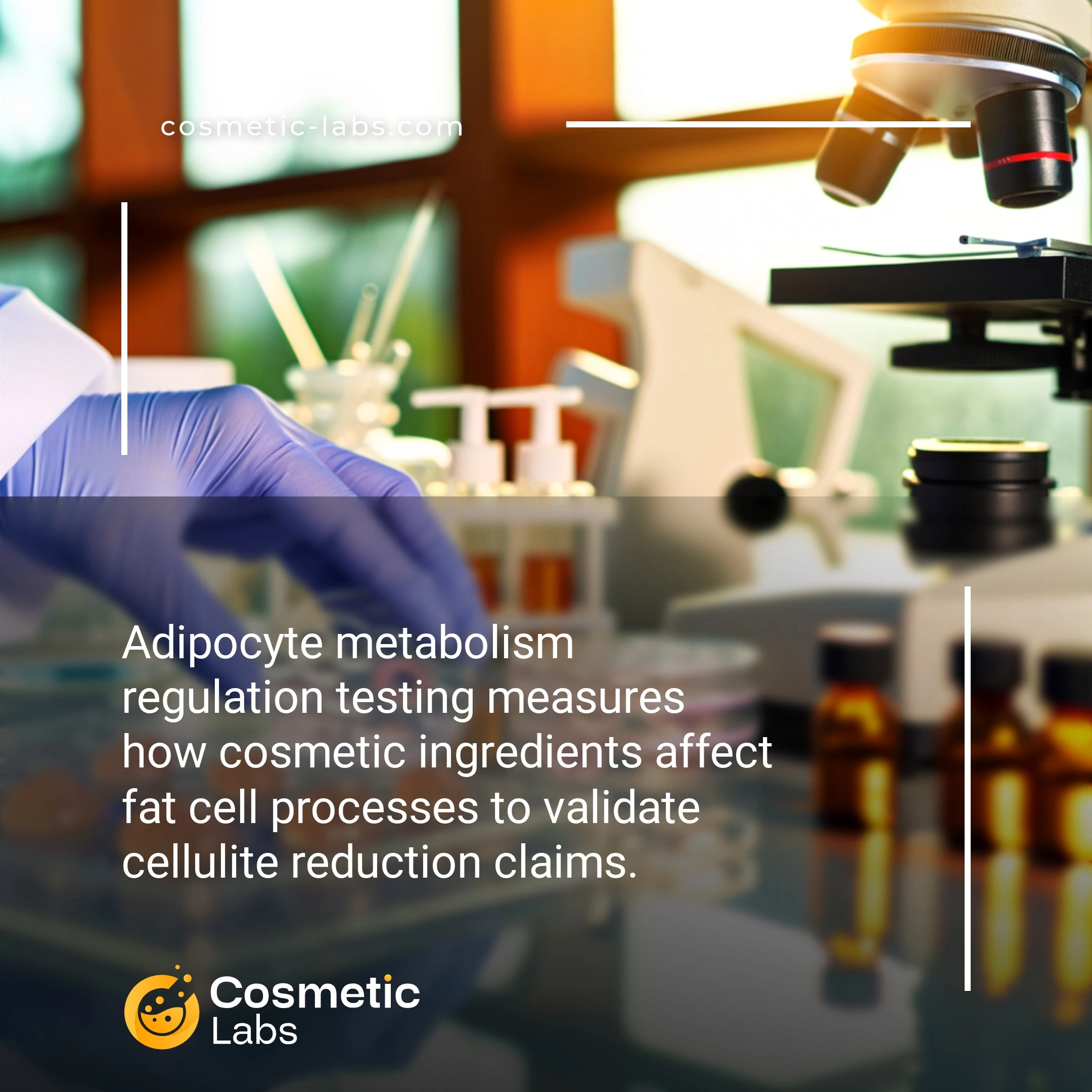Adipocyte Metabolism Testing for Cellulite Product Efficacy

What is Adipocyte metabolism regulation?
Adipocyte metabolism regulation testing for cellulite is a preclinical evaluation method that measures how cosmetic ingredients affect fat cell behavior and lipid storage processes in subcutaneous tissue. Our partner labs use lipolysis assays and adipogenesis inhibition protocols to validate anti-cellulite claims, testing whether active compounds can reduce fat cell size or prevent new adipocyte formation. This targeted approach provides the scientific data you need to support product efficacy claims before market launch.
Why do you need this service?
Cosmetic labs use adipocyte metabolism regulation testing to validate anti-cellulite formulations before market launch, measuring how active ingredients affect fat cell lipolysis and lipogenesis pathways. Brands leverage these preclinical studies to generate clinical evidence for marketing claims while optimizing ingredient concentrations during product development phases.
Who provides Adipocyte metabolism regulation services?
All cosmetic labs providing Adipocyte metabolism regulation services
There is no company providing these services at the moment.
Adipocyte Metabolism Testing for Cellulite Treatment Validation
Adipocyte metabolism regulation testing provides the scientific foundation for validating cellulite treatment efficacy in cosmetic products. Labs use specialized assays to measure how active ingredients influence fat cell behavior, lipid storage, and metabolic pathways that contribute to cellulite formation.
Lipolysis and Fat Cell Activity Assessment
Testing laboratories measure lipolytic enzyme activity and triglyceride breakdown rates in adipocyte cultures treated with your formulations. These assays track glycerol release and free fatty acid production over 24-72 hour periods.
Key parameters include:
- Hormone-sensitive lipase activation levels
- Adenylyl cyclase pathway stimulation
- cAMP concentration changes
- Perilipin protein expression modification
Results help brands understand which ingredients actually trigger fat mobilization versus those that simply claim anti-cellulite benefits.
Adipogenesis Inhibition and Cell Differentiation Studies
Labs evaluate how formulations prevent new fat cell formation through adipogenesis inhibition assays. Testing involves exposing preadipocytes to differentiation media alongside your active compounds, then measuring lipid accumulation and adipogenic gene expression.
Standard measurements include:
- Oil Red O staining for lipid droplet quantification
- PPARγ and C/EBPα transcription factor levels
- FABP4 and leptin expression analysis
- Cell proliferation rate changes
This data supports claims about preventing cellulite development and helps optimize ingredient concentrations for maximum metabolic impact. Contact labs on our platform to discuss your specific adipocyte testing requirements.
Applications of Adipocyte Metabolism Regulation Testing for Cellulite Treatments
Cosmetic labs use adipocyte metabolism regulation testing to validate anti-cellulite ingredients and formulations through controlled cellular assays and tissue models.
Ingredient Screening and Efficacy Validation
Labs screen botanical extracts, peptides, and active compounds using primary adipocyte cultures to measure lipolysis rates and fat cell size reduction. Testing protocols evaluate caffeine, retinol, and aminophylline concentrations between 0.1-5% to determine optimal dosing for cellulite reduction. Standardized assays measure triglyceride release and cellular morphology changes over 24-72 hour treatment periods.
Researchers quantify lipid droplet diameter reduction and assess metabolic enzyme activity including hormone-sensitive lipase and acetyl-CoA carboxylase. These measurements provide concrete data for ingredient suppliers and formulators developing targeted cellulite treatments.
Formulation Optimization and Mechanism Studies
Product developers use adipocyte metabolism testing to optimize delivery systems and understand how formulations affect fat cell behavior. Labs test cream bases, serums, and transdermal patches to evaluate penetration enhancers and active ingredient stability. Comparative studies reveal which delivery methods achieve the highest cellular uptake and metabolic response.
Testing includes co-culture models with fibroblasts to assess collagen synthesis alongside fat metabolism changes. This dual approach helps brands develop products that address both structural and metabolic aspects of cellulite formation.
| Testing Parameter | Measurement Method | Typical Timeline | Key Outcome |
|---|---|---|---|
| Lipolysis Rate | Glycerol release assay | 6-48 hours | Fat breakdown efficiency |
| Adipocyte Size | Microscopy analysis | 24-72 hours | Cell volume reduction |
| Enzyme Activity | Spectrophotometric assay | 4-24 hours | Metabolic pathway activation |
| Gene Expression | RT-PCR analysis | 12-48 hours | Molecular mechanism validation |
Ready to validate your cellulite treatment formulations? Contact specialized cosmetic labs on our platform to discuss adipocyte metabolism testing protocols tailored to your product development needs.
